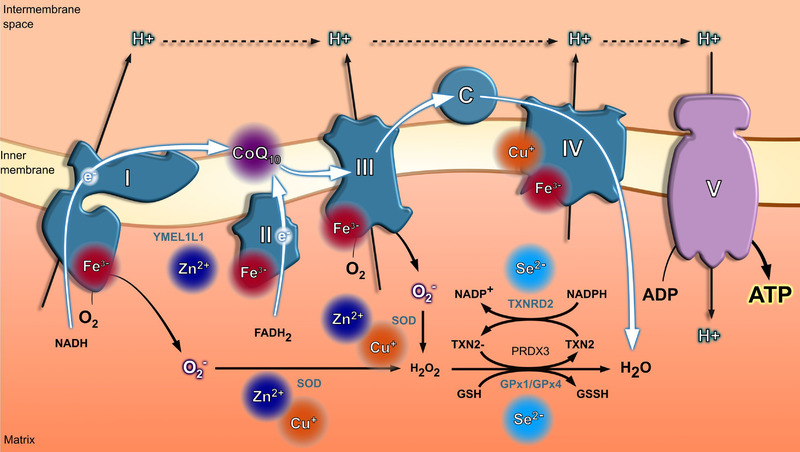Fig. 1.

Micronutrients in the mitochondrial electron transport change (mtETC). The electron transport chain (ETC) starts with a proton transfer (H+) mediated by complexes I and II, which promotes an electrochemical gradient across the mitochondrial membrane. Complex III (ubiquinol‐cytochrome c oxidoreductase or CIII) forms the central part of the mitochondrial respiratory chain, oxidizing CoQ10 and reducing cytochrome c while pumping protons from the matrix to the intermembrane space through the so‐called Q‐cycle mechanism. Finally, four cytochrome C molecules deliver an electron to complex IV (cytochrome c oxidase or CIV), being carried by the complex and transfer them to one dioxygen molecule, converting the molecular oxygen to two molecules of water. The electrochemical gradient is used by complex V (adenosine triphosphate [ATP] synthesis) to promote the generation of ATP from the available adenosine diphosphate (ADP). Although the ETC is a quite efficient mechanism to promote energy formation, the proton gradient generation results in an elevated reactive oxygen species (ROS) production due the O2 oxidation into O2 − (superoxide anion radical), H2O2 and OH (hydroxyl radical), which are the toxic products of respiration. Micronutrients present a key role in the proton gradient generation (CoQ10) and electron carrier transfer among the different complexes (Fe3+ and Cu+). Furthermore, Cu+, Zn2– and Se2− participate in the oxidant scavenger system, decreasing toxic mitochondrial ROS. Abbreviations: FADH2, flavin adenine dinucleotide; GPXs, glutathione peroxidases; GSH glutathione; reduced NADH, nicotinamide adenine dinucleotide; PRDX3, peroxiredoxin 3; SOD, superoxide dismutase; TXN2, thioredoxin 2; TXNRDs, thioredoxin reductases.
